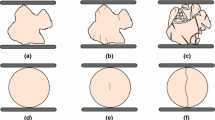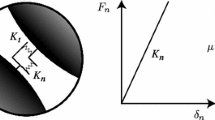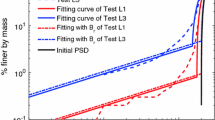Abstract
The energy dissipation from particulate systems undergoing particle crushing is often assumed to scale solely with the increase in surface area, irrespective of the strain energy stored in the surrounding media. By analyzing idealized particulate systems undergoing a single particle crushing event, this assumption is questioned and proven invalid. Two analysis types are considered. One represents the particulate system as an idealized assembly and then represents particle contact forces as members belonging to a periodic lattice. The other treats the particulate system as an elastic continuum. Different sizes of two and three dimensional particulate systems are considered, as well as isotropic and anisotropic confining stress states. The overall dissipation is shown to depend strongly on the dimensionality of the system, the anisotropy of the confining stress state and the elastic properties of the system. The ratio between dissipation due to stored elastic energy redistribution from surrounding media and dissipation by fracture surface energy is calculated. The ratio is found to diminish with the increasing dimensionality of the system. It is also shown that this ratio is independent of the fracture surface energy of the material. The most relevant analysis of a three dimensional particulate system to accurately estimate this ratio seems to be a one dimensional analysis of the force chain containing the most heavily loaded particles.










Similar content being viewed by others
References
von Rittinger, P.R.: Lehrbuch der Aufbersitungskunde. Ernst and Korn, Berlin (1867)
Chester, J.S., Chester, F.M., Kronenberg, A.K.: Fracture surface energy of the Punchbowl fault, San Andreas system. Nature 437, 133–136 (2005)
Wilson, B., Dewers, T., Reches, Z., Brune, J.: Particle size and energetics of gouge from earthquake rupture zones. Nature 434, 749–752 (2005)
McDowell, G.R., Bolton, M.D., Robertson, D.: The fractal crushing of granular materials. J. Mech. Phys. Solids 44(12), 2079–2102 (1996)
Tarantino, A., Hyde, A.F.L.: An experimental investigation of work dissipation in crushable materials. Géotechnique. 55(8), 575–584 (2005)
Adamson, A.W., Gast, A.P.: Physical Chemistry of Surfaces, 6th edn. Wiley, New York (1997)
Parks, G.A.: Surface and interfacial free energies of quartz. J. Geophys. Res. 89(B6), 3997–4008 (1984)
Einav, I., Nguyen, G.D.: Cataclastic and ultra-cataclastic shear using breakage mechanics. In: Hatzor, Y., Sulem, J., Vardoulakis, I. (eds.) Batsheva Seminar on Meso-Scale Shear Physics in Earthquake and Landslide Mechanics, chap. 8, pp. 77–87. CRC Press, London (2009)
Collins, I.F.: The concept of stored plastic work or frozen elastic energy in soil mechanics. Géotechnique 55(5), 373–382 (2005)
Nguyen, G.D., Einav, I.: The energetics of cataclasis based on breakage mechanics. Pure Appl. Geophys. 166(10), 1693–1724 (2009)
Russell, A.R.: A compression line for soils with evolving particle and pore size distributions due to particle crushing. Géotech. Lett. 1(1), 5–9 (2011)
Timoshenko, S.P., Goodier, J.N.: Theory of Elasticity, 3rd edn. McGraw Hill, New York (1970)
Wang, Y., Mora, P.: Macroscopic elastic properties of regular lattices. J. Mech. Phys. Solids 56(12), 3459–3474 (2008)
Yu, H.-S.: Cavity Expansion Methods in Geomechanics, 1st edn. Springer, Berlin (2000)
Jaeger, J.C., Cook, N.G.W.: Fundamentals of Rock Mechanics, 3rd edn. Chapman and Hall, London (1976)
Barber, J.R.: Elasticity, 2nd edn. Kluwer, Dordrecht (2002)
Russell, A.R., Muir Wood D., Kikumoto, M.: Crushing of particles in idealised granular assemblies. J. Mech. Phys. Solids. 57(8), 1293–1313 (2009)
Muthuswamy, M., Tordesillas, A.: How do interparticle contact friction, packing density and degree of polydispersivity affect force propagation in particulate assemblies? J. Stat. Mech. P09003 (2006)
Voivret, C., Radjaï, F., Delenne, J.-Y., El Youssoufi, M.S.: Multiscale force networks in highly polydisperse granular media. Phys. Rev. Lett. 102, 178001 (2009)
Ben-Nun, O., Einav, I., Tordesillas, A.: Force attractor in confined comminution of granular materials. Phys. Rev. Lett. 104, 108001 (2010)
Acknowledgments
AR would like to thank IE and The University of Sydney for hosting him during the second half of 2010 to start this work, and The University of New South Wales for relieving him of his teaching duties during that time through the Special Studies Program. IE would like to thank the Australian Research Council for funding (DP0986876 and DP1096958).
Author information
Authors and Affiliations
Corresponding author
Rights and permissions
About this article
Cite this article
Russell, A.R., Einav, I. Energy dissipation from particulate systems undergoing a single particle crushing event. Granular Matter 15, 299–314 (2013). https://doi.org/10.1007/s10035-013-0408-x
Received:
Published:
Issue Date:
DOI: https://doi.org/10.1007/s10035-013-0408-x




